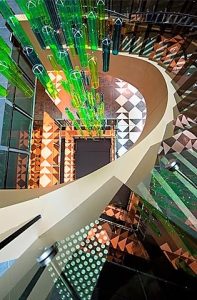THE CITY DISCOVERY SCHOOL TOUR is a journey through the Story of Melbourne from Indigenous to European occupation to the Gold Rush to the modern city. Primary, secondary or international students take a walking tour of iconic places illustrating milestones of the Melbourne CBD. These include historic and cultural sites, landmarks, lanes and arcades, architecture, heritage, street art, historic personalities and more.
OUR TWO-HOUR tours usually start and finish at Federation Square. Times and locations can be adjusted to suit.
JOURNEY through the maze of landmarks, lanes, streets and buildings that reflect important events and people from traditional owners, colonial settlement, gold rush, war, boom and bust, social movements, immigration, technology and the modern city.
STUDENTS assume the identity of a historic Melbourne personality for their journey through time. See: City Discovery Identities
EXPERIENCE interactive activities e.g. explore buildings, handle artefacts and examine historic images. Students meet challenges in a fun way that promotes learning and questioning.
OR CHOOSE one of our many alternative CBD excursions e.g. Federation, Explorer, Indigenous, Multicultural, Trade, Colonial, Community, Architecture, Science, Literature, Marvellous Melbourne, Liveability, Social Justice and more.
SEE: BOOKINGS AND PRICES
Students of all ages respond enthusiastically to this challenging and stimulating journey through the streets, lanes and arcades of the Melbourne CBD.
“Just wanted to say thank you so much for a wonderful tour yesterday. The students (and the adults) enjoyed it so much and found it so interesting. They really loved being a character and that made it so much more real for them”
St Paul’s Primary.
“Wonderful learning opportunity.”
William Angliss tertiary tourism class.
“The best tour I had ever experienced was the ‘Real San Francisco Tour’ – UNTIL I did your City Discovery Tour with our year eleven students today.”
Aquinas College.
“Your tour yesterday was a fantastic opportunity for our students to actually look around Melbourne and learn about its history at the same time. They have all given back excellent feedback about the experience. The students absolutely loved when they heard information about their person that they were given as an identity. We gathered an abundant number of facts that we will collate today during class.”
Wallarano College.
“We absolutely loved your walking tour. We watched the video we took yesterday, and I couldn’t believe how strong the students’ recall was – they took in all that you shared with them.”
Upper Beaconsfield Primary.
The places we go tell important stories of Melbourne’s heritage. The route may vary according to time, weather, construction, age and learning goals.
- 1835 – Fed Square/Yarra River: Welcome to country. Impact of settlement on Nearamnew.
- 1850s to 1930 – St Paul’s Cathedral: Church of England, Eureka protests, the birth of democracy and the Gold Rush.
- 1835 – 1850 – Young and Jackson: John and Eliza Batman, The Melbourne Treaty.
- 1840-1880’s – Flinders Lane: The great heritage warehouses, shipping lane
- 1854/1910 – Flinders Street Station: The first steam train.
- 1860’s – Royal Arcade 1869: Gold rush, oldest Australian arcade, icons of Melbourne
- 1870s – Bank of Australasia 1872: Marvellous Melbourne Collins Street.
- 1887 – The Gothic Bank and Stock Exchange: The building of Melbourne.
- 1880s -The GPO building 1886: Early communication, retail, changes in technology, retail. First trams in 1885.
- 1880’s – The Coles Book Arcade: 1886 spiritualism, City of Literature 2008
- 1890’s – The Block Arcade: 1891: Marvellous Melbourne promenade, Victoriana. Social life.
- 1890 – 333 Collins: The Great Dome. From Boom to Depression
- 1890’s – Presgrave Lane: Marvellous Smellboom. Sewage and pollution and factories. The flight to the suburbs
- 1901 – Federation Square: Birth of a nation from six British colonies.
- 1910 – Myers 1910: Early Commerce, Art Deco.
- 1920s – Presgrave Lane: Squizzy Taylor and prohibition. Street art
- 1920’s – Nicholas Building 1927: Jazz Age. Fashion and textiles. Art Deco. The creative city.
- 1930’s – Manchester Unity building: 1933, The Great Depression.
- 1980’s – Centreway Arcade: 1984 Architecture and Riddles. Globalisation.
- 1990s – Degraves Street and Centre Lane: 1990’s urban renaissance in the lanes.
- 2010 – City Square: Multiculturalism, Melbourne’s Sister Cities, Immigration, Metro tunnel.
- 2017 – 260 Collins Street: St Collins, A new Melbourne lane and architecture
VIDEOS:
RESOURCES:
PHOTO GALLERY:


















